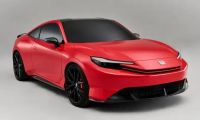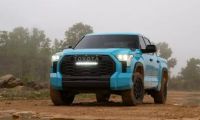An affordable electric car with a long driving range could change the direction of electric car adoption. That's the goal of IBM Research's Battery500 project, a long-term research project into using LIthium-Air technology to develop an ultra-high-density lithium battery solution. IBM announced today a partnership with Asahi Kasei and Central Glass to collaborate on developing lithium-air battery technology.
Lithium-Air batteries consume oxygen from the atmosphere, storing that oxygen in chemical reactions inside the battery, while releasing electricity. Oxygen atoms are absorbed through a nanostructured carbon layer, combining with lithium ions to form lithium peroxide. As this reaction occurs, electricity is released that can for example be used to power a car. Later when the battery is recharged, the oxygen is released back into the atmosphere. Hence the lithium-air battery breathes, in a manner of speaking. As a side note, gasoline engines also inhale atmosphere, but the exhale of the gasoline engine is filled with a toxic soup of chemicals left over from the gasoline combustion. Both the inhale and exhale of the lithium-air battery is oxygen.
Lithium-air batteries are attractive because of the extremely high energy density. Today's lithium-ion batteries have an energy density between 100-250 watt-hours per kilogram, and lithium-air has an energy density approaching gasoline. This means a lithium-air battery pack with the weight of a tank of gasoline would hold nearly the energy equivalent of gasoline. IBM portrays lithium-air as the technology which will enable a 500 mile range electric car. Poly-Plus is another company researching lithium-air battery technology, and other companies such as Envia Systems are researching higher energy density lithium-ion batteries.
An electric car with a 500 mile range per charge is quite possible today. Tesla Motors is about to begin production of the Model S, with a 300 mile range per charge provided by an 85 kilowatt-hour battery pack, while IBM sees the 500 mile lithium-air car will have a 150 kilowatt-hour battery pack. It stands to reason that a car with that large a battery pack could be constructed today, but would it be affordable? This is the primary factor into why the Mitsubishi i-MiEV has a 60-70 mile range, the Nissan LEAF has an 80-100 mile range, and so on, is that manufacturers targeting an affordable price range cannot use a large battery pack at todays battery prices. For more about what a 500 mile electric car could mean, see What a 500 miles electric car means to you and me.
Today's announcement is about bringing deep materials science expertise to IBM's lithium-air research project. Asahi Kasei and Central Glass are expected to "expand the project’s scope" by "exploring several chemistries simultaneously". IBM sees this research project as extremely risky with huge technical challenges and strongly caution us to not expect any practical result until the mid-2020's at least, however bringing these two companies on-board increases the chances of success.
Asahi Kasei is described as "one of Japan's leading chemical manufactures and a leading global supplier of separator membrane for lithium-ion batteries". That company will help to develop a membrane for IBM's lithium-air battery. These membranes are used to separate the chemicals inside the battery to ensure that only the desired chemical reactions occur.
Central Glass is described as "a leading global electrolyte manufacturer for lithium-ion batteries" and will be involved in developing "electrolytes and high-performance additives specifically designed to improve lithium-air batteries".
“These new partners share our vision of electric cars being critical components of building a cleaner, better world, which is far less dependent on oil,” said Dr. Winfried Wilcke, IBM’s Principle Investigator who initiated the Battery 500 Project. “Their compatible experience, knowledge and commitment to bold innovation in electric vehicle battery technology can help us transfer this research from the lab onto the road.”
“We are very focused on addressing environmental challenges and limitations with diverse technology to build a brighter future. This alliance allows us to explore a new path to developing an improved rechargeable battery performance that can not be met with conventional technologies,” said Tetsuro Ohta, Head of Advanced Battery Materials Development Center, Asahi Kasei.
The lithium-air technology being developed by IBM's Battery500 research project is a long way from being manufacturable. For example the team only just were able to demonstrate a battery design which can be recharged and discharged through multiple charge cycles with some degree of stability. One of the technical challenges cited by Dr. WIlcke in a recent talk is the need for dry air, and obviously the atmosphere routinely has a lot of moisture in it. Hence, the lithium-air battery might need to be surrounded by an air drying machine that would make the battery larger than might otherwise be required. Dr. WIlcke's prediction is that, depending on how quickly the technical challenges can be solved, lithium-air battery technology could be productizable sometime in the 2020's, with it likely to be closer to 2030.












Comments
I find it refreshing that an
Permalink
I find it refreshing that an article points to cost, not achievable driving range as the obstacle to mass production of EVs.
It is certain that very cost efficient batteries are on the relatively near horizon. If I were head of IBM I would immediately cancel their air battery effort. Even if it succeeds, it will likely be totally obsolete by the time that happens. Both Toyota, in collaboration with the Tokyo Institute of Technology, which makes MIT' s battery efforts look sick and amateurish (their slippery cell for example), are promising batteries 5 to 10 times cheaper in the next 5 years, as has German firm BDM-Energy.
"...are promising batteries 5
Permalink
In reply to I find it refreshing that an by Anonymous (not verified)
"...are promising batteries 5 to 10 times cheaper in the next 5 years..."
Promises are just promises: delays, roadblocks, and downright dead-ends often occur. Until something actually hits the market it is nothing but airware: smoke and mirrors. If all company A needs to do to stop company B from beating them to market with competing technology is to say "Hey, I have a world-beater that will make yours obsolete" then very little progress will occur because there is no incentive to proceed. You should never make the Perfect the enemy of the Good. If the Good hits the market in 3-4 years and the Better hits the market 1-2 years later, by then the Good will have made further advancements to approach the efficiency or drop the cost enough that it stays competitive (or maybe it does die, but that's the way of technology). I say keep every research route going full blast and see what shakes out.